World War 2 Plane Pen and Ink Drawing
| U.Due south. Army Vietnam Combat Artists Program | |
|---|---|
| LOOKING DOWN THE TRAIL Watercolor James Pollock, CAT 4, 1967 Courtesy of the National Museum of the U.S. Ground forces | |
| Active | (June 1966–1970) |
| Country | The states of America |
| Allegiance | U.s.a. of America |
| Branch | Usa Army |
In June 1966, the Army Vietnam Combat Artists Program was established as part of the United States Army Art Program, utilizing teams of soldier-artists to make pictorial records of U.S. Army activities in the course of the Vietnam State of war for the annals of armed forces history. The concept of the Vietnam Combat Art Programme had its roots in World State of war II when the U.S. Congress authorized the Army to use soldier-artists to tape military operations in 1944.[1]
During the Vietnam Era, the U.Southward. Army Chief of Military History asked Marian McNaughton, so Curator for the Army Art Collection, to develop a plan for a Vietnam soldier art program. The result was the cosmos in 1966 of the U. S. Army Vietnam Gainsay Art Program nether the direction of the Role of Main of Military History and McNaughton'due south part. Her programme included involving the U.S. Army Arts and Crafts Program, then headed by Eugenia Nowlin. McNaughton'due south office relied on Nowlin and her cadre of local Army Craft directors to solicit applications from soldiers, which were forwarded to McNaughton's office at the U.South. Regular army Middle of Armed forces History, where choice and team assignments were made.[2] The U.S. Regular army provided logistics support as the teams of artists were sent to Vietnam and then to Hawaii.[3]
Artists interested in joining the programme were asked to submit applications through the Army Arts and Crafts Plan facilities nearest their unit.[4] Applications were to contain samples of drawings, photographs of paintings and a resume. Selections were made by a committee equanimous of designated representatives from the Function, Master of Military History and the Adjutant General'southward Office. Supervised past Ground forces Art Curator Marian McNaughton.[2] The program was the joint responsibility of the Office, Chief of Military History, and the Adjutant General'due south Office with back up from the Office, Chief of information.[3]
History [edit]
Ix Combat Creative person Teams (CATs) operated in Vietnam.[5] Typically, each team consisted of v soldier artists who spent 60 days of temporary duty (TDY) in Vietnam gathering data and making preliminary sketches of U.S. Ground forces related activities. The teams then transferred to Hawaii for an additional 75 days to finish their work. Artists were given artistic liberty and encouraged to depict subjects in their own individual styles. Art created by soldier artists became a part of the U.Southward. Army Art Collection maintained by the U.S. Ground forces Center of Military machine History (CMH), Washington, D.C.[iii]
On 17 March 1969, due to the widespread interest shown by soldier artists and the touch on of their work throughout the Army, the official proper name was inverse from the VIETNAM Combat ART Programme to the ARMY Artist PROGRAM. Coverage was expanded to include portraying the U.Due south. Ground forces worldwide.[6]
U.Southward. Army soldier artist participants [edit]

Roger Blum, Vietnam Combat Creative person Squad I, discusses his painting "Attack at Twilight," completed with acrylic. The painting was inspired by Blum's first view of a burning "hooch," or hut, and he used dramatic lighting to emphasize the emotion of the painting.
List of U.S. Army Vietnam Combat Artist Squad (Cat) members and supervisors from xv August 1966 – xiv January 1970. (Cities listed reflect data on original applications which are currently in archives of U.South. Army Eye of Armed forces History).
- CAT I, 15 Aug - xv Dec 1966, Roger A. Blum (Stillwell, KS), Robert C. Knight (Newark, NJ), Ronald E. Pepin (East Hartford, CT), Paul Rickert (Philadelphia, PA), Felix R. Sanchez (Fort Madison, IA), John O. Wehrle (Dallas, TX), and supervisor, Frank M. Sherman.
- CAT Two, 15 Oct 1966 – fifteen Feb 1967, Augustine M. Acuna (Monterey, CA), Alexander A. Bogdanovich (Chicago, IL), Theodore Eastward. Drendel (Naperville, IL), David M. Lavender (Houston, TX), Gary W. Porter (El Cajon, CA), and supervisor, Carolyn M. O'Brien.
- CAT III, 16 Feb - 17 June 1967, Michael R. Crook (Sierra Madre, CA), Dennis O. McGee (Castro Valley, CA), Robert T. Myers (White Sands Missile Range, NM), Kenneth J. Scowcroft (Manassas, VA), Stephen H. Sheldon (Los Angeles, CA), and supervisor, C. Bruce Smyser.
- CAT IV, 15 Aug - 31 December 1967, Samuel E. Alexander (Philadelphia, MS), Daniel T. Lopez (Fresno, CA), Burdell Moody (Mesa, AZ), James R. Pollock (Pollock, SD), Ronald A. Wilson (Lakewood, CA), and technical supervisor, Frank Yard. Thomas.
- Cat Five, 1 Nov 1967 – fifteen March 1968, Warren W. Buchanan (Kansas Urban center, MO), Philip 5. Garner (Dearborn, MI), Phillip W. Jones (Greensboro, NC), Don R. Schol (Denton, TX), John R. Stiff (Kanehoe, Hi), and technical supervisor, Frank G. Thomas.
- True cat VI, 1 Feb - 15 June 1968, Robert T. Coleman (M Rapids, MI), David N. Fairrington (Oakland, CA), John D. Kurtz IV (Wilmington, DE), Kenneth T. McDaniel (Paris, TN), Michael P. Pala (Bridgeport, CT).
- CAT 7, 15 Aug - 31 Dec 1968, Brian H. Clark (Huntington, NY), William E. Flaherty Jr. (Louisville, KY), William C. Harrington (Terre Haute, IN), Barry W. Johnston (Huntsville, AL), Stephen H. Randall (Des Moines, IA), and supervisor, Fitzallen North. Yow.
- True cat 8, ane Feb - 15 June 1969, Edward J. Bowen (Carona Del Mar, CA), James R. Drake (Colorado Springs, CO), Roman Rakowsky (Cleveland, OH), Victory V. Reynolds (Idaho Falls, ID), Thomas B. Schubert (Chicago, IL), and supervisor, Fred B. Engel.
- CAT IX, ane Sept 1969 - 14 Jan 1970, David E. Graves (Lawrence, KS), James S. Hardy (Coronado, CA), William R. Hoettels (San Antonio, TX), Bruce North. Rigby (Dekalb, IL), Craig 50. Stewart (Laurel, MD), and supervisor, Edward C. Williams.[seven]

NURSING by Robert C. Knight, CAT I, 1966, Courtesy of the National Museum of the U.Due south. Army
James Pollock, who in 1967 served every bit a soldier artist on U. S. Army Vietnam Combat Creative person Team IV (Cat Iv), chronicled his experience in an essay entitled "Us Army Soldier-Artists in Vietnam" for "War, Literature & the Arts: An International Journal of the Humanities"[7] published by the department of English language and Fine Arts, U.s.a. Air Force University. In the essay Pollock wrote: "The idea of rotating teams of young soldier-artists from a variety of backgrounds and experiences through Vietnam was innovative. Soldier-artists were encouraged to freely express and interpret their private experience in their own singled-out styles. The artists responded enthusiastically to their creative gratis reign [sic], and the resulting products were wide-ranging and comprehensive. Styles and media used were as diverse equally the artists themselves, some chose detailed literal images while others preferred expressive almost abstruse explosions striving to replicate the horrors of war".[7]
Army artists subsequently Vietnam [edit]
During the Vietnam State of war the ground forces art program also used civilian artists. While the last team of soldier artists in Vietnam was Soldier Art Team 9 (CAT IX) the Army's involvement in using artists to depict army activities connected. The 1991 volume "Portrait of an Army", published by U. S. Army Center of Military History and edited by General Gordon R. Sullivan and Marylou Gjernes, states "Post-obit the Vietnam State of war, the Army connected to use both soldier and civilian artists. They accept covered such peacetime activities as summer training for Reserve Officers' Training Corps (ROTC) West Signal cadets, Army National Guard annual grooming, and tank gunnery preparation in Europe. The Army Art Drove has besides acquired depictions of the Army'south operations in Panama and Operations DESERT SHIELD and DESERT Storm."[ane]
In 2003, quondam Vietnam soldier-creative person James Pollock gave a presentation entitled "U. S. Ground forces Vietnam Gainsay Art Plan" almost Vietnam Era soldier artists at Mary Pickford Theater, U. S. Library of Congress[viii] at which he said: "On January 14, 1970, the members of Vietnam Combat Art Squad Nine (Cat Nine), the concluding U.S. Army art team to set human foot in Vietnam, disbanded. Like members of 8 other Army soldier-artist teams before them, they left their sketchbooks and paintings of war-torn Vietnam behind and quietly returned to their corresponding war machine units scattered throughout the earth or were re-assigned. Talent and take chances had brought 46 immature soldiers together for a common purpose: To be artists day in and day out for 120 days and to translate their personal Vietnam experiences every bit soldiers into fine art. All of the artists were exposed to the inherent dangers of existence in a war zone. While visiting units in the fields of Vietnam, they encountered hard weather and some had to deal with life-threatening incidents. None were wounded or killed. The post-Vietnam Era destiny of these soldier artists varied as they went on to establish and nurture families and careers. Some continued successfully every bit artists, some became art teachers, some laid down their paint brushes and found careers outside the field of art. Some have died, and the whereabouts of others is unknown".[v]
Public showings [edit]
From September 2010 to March 2011, the National Constitution Heart in Philadelphia, PA hosted an exhibit entitled "Art of the American Soldier" featuring more than 300 works from the regular army art collection, i of the first times that the Army Art from the Ground forces Art Plan has been put on display en masse.[nine]
In June 2015, Southward Dakota Public Broadcasting interviewed combat creative person James Pollock well-nigh his experiences in the Vietnam Combat Fine art Program.[10]
In September 2017, South Dakota Public Broadcasting produced a video about the Vietnam Combat Artists Program entitled "The Art of War" as part of their SD Vietnam Stories project produced to accompany the circulate of Ken Burns' "The Vietnam State of war" series.[11]
See also [edit]
- U.s.a. Army Fine art Program
- Us Air Forcefulness Art Program
- American official war artists
Art Gallery (All Images Courtesy of the National Museum of the U.Due south. Army) [edit]
True cat I xv Baronial to 15 December 1966 [edit]
-
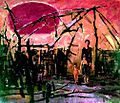
THE LOST OF WAR by Roger A. Blum, CAT I, 1966
-

ELEPHANT GRASS by Roger A. Blum, Cat I, 1966
-

GRENADE THROWER by Roger Blum, True cat I, 1966
-

SWAMP PATROL by Roger Blum, Cat I, 1966
-
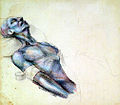
WOUNDED by Robert C. Knight, CAT I, 1966
-

NURSING by Robert C. Knight, Cat I, 1966
-

PAGE FROM SKETCHBOOK by Robert C. Knight, CAT I, 1966
-

RELIGIOUS SERVICES 1st CAV AKA THY ROD and THY STAFF, THEY COMFORT ME by Paul Rickert, CAT I, 1966
-

BOG-DOWN by Felix R. Sanchez, True cat I, 1966
-

INTENSIVE Care WARD third FIELD Infirmary RVN by John O. Wehrle, CAT I, 1966
-

Set on AT TWILIGHT by Roger Blum, CAT I, 1966
-

INFANTRY SOLDIERS by Roger Blum, True cat I, 1966
-

CONVOY by Roger Blum, CAT I, 1966
-

CONVOY THROUGH SAIGON by Robert Knight, True cat I, 1966
-

REINFORCEMENTS LANDING by Ronald Pepin, True cat I, 1966
-

SEARCHING A VILLAGE by Robert Knight, True cat I, 1966
-

SWAMP PATROL by Felix Sanchez, CAT I, 1966
-

TANK IN HOBO WOODS past Ronald Pepin, Cat I, 1966
-

VIETNAMESE SOLDIERS BOARD HELICOPTER by Robert Knight, True cat I, 1966
Cat Two 15 October 1966 to xv February 1967 [edit]
-

SCOUT Canis familiaris past Augustine One thousand. Acuna, CAT II, 1966–67
-

Torso COUNT by Alexander A. Bogdanovich, CAT Two, 1966–67
-

RECONNAISSANCE PATROL NEAR SOUTH Mainland china SEA by David M. Lavander, Cat II, 1966–67
-

2d PLATOON ASSAULT by Gary W. Porter, Cat II, 1966–67
-

BEAT past Augustine M. Acuna, CAT II, 1966–67
-

BIRDS OF PREY past Augustine 1000. Acuna, Cat II, 1966–67
-

INTERROGATION by Augustine G. Acuna, True cat Ii, 1966–67
-

MEMBERS OF THE Civilian IRREGULAR DEFENSE GROUP by Augustine G. Acuna, True cat Two, 1966–67
-

SKETCH OF A SOLDIER I by Theodore E. Drendel, Cat II, 1966–67
-

SKETCH OF A SOLDIER II past Theodore Eastward. Drendel, CAT Two, 1966–67
-

STREET SCENE by David M. Lavender, Cat 2, 1966–67
-

THE BARBER by Alexander A. Bogdanovitch, True cat II, 1966–67
-

THE RICE PADDIES by Augustine G. Acuna, CAT Ii, 1966–67
-

THE VETERAN by Augustine G. Acuna, CAT 2, 1966–67
-

VIETCONG by Gary W. Porter, True cat Two, 1966–67
-

WAITING by Gary Due west. Porter, CAT II, 1966–67
CAT III 16 February 1967 to 17 June 1967 [edit]
-

MONTAGNARD NEAR PLEIDJERONG I by Michael R. Crook, CAT Iii, 1967
-

MED CAP by Dennis O. McGee, CAT III, 1967
-

PERIMETER OF Arty Pass AT Acquit CAT past Robert T. Myers, Cat III, 1967
-

THE INNOCENT past Kenneth J. Scowcroft, CAT III, 1967
-

Later on THE Boxing by Stephen H. Sheldon CAT III 1967
-

CHAPLAIN MARTINS BIBLE Stephen H. Sheldon, CAT III, 1967
-

9TH INFANTRY Segmentation GI by Michael R. Crook, True cat Iii, 1967
-

PERIMETER PATROL by Michael R. Crook, True cat 3, 1967
-

ARMORED VEHICLE AT BONG SON by Dennis O. McGee, True cat Three, 1967
-

CHIEU HOI OR DIE by Michael R. Cheat, True cat Three, 1967
-

DELTA Grit OFF past Robert T. Myers, CAT 3, 1967
-

DELTA SUNRISE by Stephen H. Sheldon, CAT Iii, 1967
-

EASTER SUNRISE by Michael R. Crook, Cat III, 1967
-

GUNSHIP IN THE DELTA by Stephen H. Sheldon, CAT Three, 1967
-

WELCOME RELIEF past Kenneth J. Scowcroft, Cat III, 1967
CAT 4 15 Baronial to 31 December 1967 [edit]
-

GI CONVOY-Piece of cake TOUCH past Samuel East. Alexander, CAT Four, 1967
-

AMERICAN DOCTOR EXAMINES VIETNAMESE Kid by Samuel E. Alexander, True cat 4, 1967
-

RECONNAISSANCE, LONG BINH past Daniel T. Lopez, True cat Iv, 1967
-

CHARLIE SUBDUED past Burdell Moody, Cat IV, 1967
-

KILLED IN ACTION by Burdell Moody, Cat IV, 1967
-

Nighttime Performance past Burdell Moody, CAT IV, 1967
-

BIG AND Piddling FIREPOWER by Burdell Moody, Cat IV, 1967
-

LOOKING Downwardly THE TRAIL, Watercolor, by James Pollock, CAT 4, 1967
-

WAITING INTERROGATION,199th LT INF BG, Watercolor, by James Pollock, Cat IV, 1967
-

WAITING TO Lift OFF, Ink/Watercolor Wash, by James Pollock, True cat 4, 1967
-

MED EVACUATION (93rd EVACUATION), Oil, by James Pollock, CAT IV, 1967
-

FIELD HAIRCUT AT BIG RED 1, Ink/Watercolor launder, by James Pollock, Cat 4, 1967
-

AIR CONTROLLER 196th LIB, Pen and Ink, by James Pollock, CAT 4, 1967
-
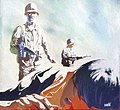
UNREAL by Ronald A. Wilson, Cat IV, 1967
-

LOADED by Ronald A. Wilson, CAT IV, 1967
-

Chilling Ronald A. Wilson, CAT IV, 1967
-

JUNGLE COLUMN by Samuel B. Alexander, CAT IV, 1967
-

TEN MINUTE Interruption by Samuel B Alexander, CAT IV, 1967
-

Between PATROLS 199TH Virtually Cat LAI past James Pollock, True cat Four, 1967
-

COBRAS past Ronald A. Wilson, CAT IV, 1967
-

JUNGLE by Ronald A. Wilson, True cat Iv, 1967
-

LIFELINE by Ronald A. Wilson, CAT IV, 1967
-

Marking by Ronald A. Wilson, Cat IV, 1967
-

STARLIGHT by Ronald A. Wilson, Cat Iv, 1967
-

VC past Ronald A. Wilson, True cat Iv, 1967
-

UNTITLED CHOPPERS by James Pollock, Cat IV, 1967
CAT Five 1 Nov 1967 to 15 March 1968 [edit]
-

LISTENING by Warren Westward. Buchanan, Cat V, 1967–68
-

HURT by Philip V. Garner, CAT Five, 1967–68
-

Final Stand up by Phillip W. Jones, True cat Five, 1967–68
-

THE ENEMY? by Don R. Schol, CAT V, 1967–68
-

three War Homo by John R. Strong, CAT V, 1967–68
-

A Hat FOR A LADY by Philip W. Jones, Cat 5, 1967–68
-

DONG TAM SCENE past Don R. Schol, CAT Five, 1967–68
-

REFUELING by Warren W. Buchanan, True cat V, 1967–68
-

REPLACEMENTS by John R. Strong, CAT V, 1967–68
-
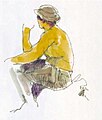
UNTITLED by Philip W. Jones, CAT V, 1967–68
-

Vietnamese Woman by Philip V. Garner, True cat V, 1967–68
CAT VI 1 Feb 1968 to 15 June 1968 [edit]
-

5th SPECIAL FORCES PATROL past Robert T. Coleman, True cat Vi, 1968
-

SEARCH FOR AMMO CACHE (11th CAV) by Robert T. Coleman, Cat Vi, 1968
-

TROOP Command Postal service by Robert T. Coleman, Cat 6, 1968
-
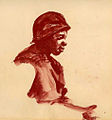
CAVALRY TROOPER past John D. Kurtz IV, CAT VI, 1968
-

CHOPPERS past John D. Kurtz 4, True cat 6, 1968
-

UNTITLED by Kenneth T. McDaniel, CAT VI, 1968
-

POTABLE H2o by Michael P. Pala, CAT VI, 1968
-

Suspension TIME by Kenneth T. McDaniel, Cat Six, 1968
-

Member OF AIR Force SPECIAL TROOPS by David Northward. Fairrington, CAT Half dozen, 1968
-

Sentry past Michael P. Pala, CAT Half dozen, 1968
Cat VII 15 August 1968 to 31 December 1968 [edit]
-

CHOPPER Pick-Upwardly past Brian H. Clark, CAT Seven, 1968
-

SOLDIER RESTING by William Due east. Flaherty Jr., CAT VII, 1968
-

S & D MISSION by William E. Flaherty Jr., CAT 7, 1968
-

APC-RPG-1 past William C. Harrington, Cat Seven, 1968
-

MEDCAP by Barry Due west. Johnston, True cat VII, 1968
-

500 METERS TO THE Front end past Barry Westward. Johnston, CAT VII, 1968
-

FIREFIGHT past Stephen H. Randall, True cat VII, 1968
-

Letter of the alphabet TO HOME past Stephen H. Randall, CAT VII, 1968
-
COBRA by Stephen H. Randall, Cat VII, 1968
-
HARD LABOR by Stephen H. Randall, CAT Vii, 1968
-

FLAMER by Stephen H. Randall, Cat 7, 1968
-
Go THEM OUT by Stephen H. Randall, Cat Seven, 1968
-
I See IT past Stephen H. Randall, CAT VII, 1968
-
SOLDIERS past Stephen H. Randall, Cat Vii, 1968
-

TANK by Stephen H. Randall, Cat VII, 1968
-
SILENT SWEAT by Stephen H. Randall, True cat 7, 1968
-
OVER THERE by Stephen H. Randall, Cat VII, 1968
-

Figure STUDY by Stephen H. Randall, True cat VII, 1968
-

EARLY MORNING by Stephen H. Randall, CAT VII, 1968
-

DOCK OF THE BAY by Stephen H. Randall, CAT VII, 1968
-

Advice by Stephen H. Randall, True cat VII, 1968
-
MOUNTAIN CLIMBER past Stephen H. Randall, CAT Seven, 1968
-

AMERICAN GOTHIC by William C. Harrington, CATVII, 1968
-

Captive past Barry W. Johnston, True cat 7, 1968
-

DUST OFF ALOFT by Brian H. Clark, CAT 7, 1968
-

HARD LABOR IN A RICE PADDY by Stephen H. Randall, CAT VII, 1968
-

LOADING DOCK past Unknown Creative person, CAT 7, 1968
Cat VIII 1 February 1969 to 15 June 1969 [edit]
-

Military camp IN AMERICAN Partition by Edward J. Bowen, True cat Viii, 1969
-

SATURDAY UPTOWN by James R. Drake, CAT VIII, 1969
-

LONG RANGE PATROL by James R. Drake, True cat VIII, 1969
-

BODY COUNT No. 5 by Roman Rakowskky, CAT Eight, 1969
-

PRISONER BLINDFOLDED by Roman Rakowsky, Cat Viii, 1969
-

Gainsay ENGINEER by Victory V. Reynolds, Cat VIII, 1969
-

BRIDGE BUNKER WITH Baby-sit by Thomas B. Schubert, CAT VIII, 1969
-

DAN TIENG OBSERVATION Tower by Thomas B. Schubert, CAT 8, 1969
-

APC by Edward J. Bowen, CATVIII, 1969
-

MARKET Identify by Victory 5. Reynolds, True cat Viii, 1969
-

ON A LONG RANGE PATROL by James R. Drake, True cat VIII, 1969
-

WAITING past Victory Five. Reynolds, CAT VIII, 1969
CAT Nine 1 September 1969 to fourteen Jan 1970 [edit]
-

APC by David E. Graves, CAT IX, 1969–70
-

RICE PADDY by James S. Hardy, CAT IX, 1969–lxx
-

RICE Manufacturing plant, MY THO past William R. Hoettels, Cat IX, 1969–70
-
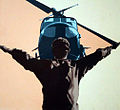
GROUND GUIDE by Bruce N. Rigby, True cat IX, 1969–70
-

CHIEU HOI MISSION past Craig Fifty. Stewart, CAT IX, 1969–lxx
-

APC ON THE DMZ by James Southward. Hardy, CAT 9, 1969–seventy
-

BIEN DIEN Span by William R. Hoettels, CAT IX, 1969–70
-

DELTA VILLAGE by William R. Hoettels, Cat Ix, 1969–70
-

FIREBASE RENDEZVOUS by Craig L. Stewart, CAT 9, 1969–70
-

Thousand-48 TANK by David E. Graves, CAT IX, 1969–lxx
-

TANK past Bruce N. Rigby, Cat IX, 1969–lxx
References [edit]
- ^ a b "Portrait of an Army" General Gordon R. Sullivan, Editor; Marylou Gjernes, Art Editor. (Center of Military machine History, United States Army, Washington, D.C. 1991), pp. 177-179.
- ^ a b McNaughton, Marian R. Phone Interview with James Pollock 10 August 2003. (During the Vietnam War era McNaughton was Curator of Paintings, Army Art Collection, Office Main of Armed services History).
- ^ a b c "Announcement of U.s. Army Vietnam Gainsay Artist Program for FY 1968 including overview and application instructions", U.Due south. Ground forces CIRCULAR No. 28-30,(Publication from Headquarters Department of the Ground forces, Washington, D.C., 20 July 1967).
- ^ "US Army Vietnam Combat Artist Plan Fact Sheet Dated xv July 1967." U.Southward. Army Official Publication, (Prepared by The states Army in the Republic of Vietnam (USARV) Control Historian fifteen July 1967).
- ^ a b "United States Army Vietnam Combat Art Program", James Pollock, (2003 Lecture), (Presentation given at U. S. Library of Congress, Mary Pickford Theater, Tuesday, 15 July 2003, Presentation Sponsor, Library of Congress Professional Association (LCPA) Veterans Forum, Washington, D.C.). CD of presentation in PDF format and tin be found in U.S. Library of Congress Athenaeum. Presentation was also videotaped and in LOC archives.
- ^ "Ground forces Combat Artist Program. Soldier Art From Vietnam Presented by the Department of the Army." U. Due south. Section of the Regular army Pamphlet,(Pamphlet distributed by The Aide Full general, Section of the Regular army, Washington, D.C. 1969.
- ^ a b c "U. S. Army Soldier Artists in Vietnam," James Pollock,"War, Literature & the Arts", An International Periodical of the Humanities, (Volume 21, 2009, ISSN 1046-6967 Published by the Department of English language and Fine Arts, United States Air Force Academy, Colorado Springs, Colorado), pp. 247-272. (in public domain) essay: artwork: Archived 13 May 2011 at the Wayback Car
- ^ "Pictures Tell Story of U.Southward. Army Combat Art Programme," Sarah Rouse, (Library of Congress THE GAZETTE, a Weekly Newspaper for the Library Staff, Volume fourteen, No 30, five September 2003 ISSN 1049-8184, James Madison Memorial Edifice LM5, Library of Congress, Washington, D.C.) p. 11.
- ^ "Art of the American Soldier". National Constitution Center. Archived from the original on 12 June 2010. Retrieved 29 June 2010.
- ^ "SDPB Radio MIDDAY with Karl Gehrke June ten, 2015". Due south Dakota Public Dissemination. Retrieved 13 September 2017.
- ^ "The Art of War". Southward Dakota Public Broadcasting. Retrieved four September 2017.
External links [edit]
- Artwork from the Art Plan at the United States Army Center of War machine History webpage
- Humanities Magazine September/October 2011: Volume 32, Number 5
- Most calorie-free and dark in peace and war and a piece of Vietnam by Lance Nixon, Uppercase Journal (Southward Dakota), 17 January 2014.
- Cartoon fire by Lance Nixon, Upper-case letter Journal (South Dakota), 23 Jan 2014.
- A photograph of a war is unlike from a painting "that'due south not rocket scientific discipline" by Dave Askins, Capital Periodical (South Dakota), 20 April 2018.
- Combat artists share ware experiences by Kerri Lawrence, National Archives News, nine April 2018
- National Aarchives Facebook Gainsay Art Panel
- Us Army Soldier-Artists in Vietnam (CAT Iv, 15 August to 31 December, 1967) by James Pollock, War, Literature & the Arts: An International Periodical of the Humanities, costless downloadable PDF South Dakota State University Open PRAIRIE repository/2009 Volume 21
- SDPB Radio Interview MIDDAY Karl Gehrke interviews James Pollock, 10 June 2015.
Source: https://en.wikipedia.org/wiki/Vietnam_Combat_Artists_Program









0 Response to "World War 2 Plane Pen and Ink Drawing"
Post a Comment